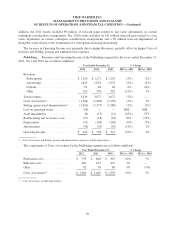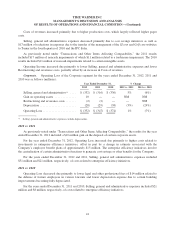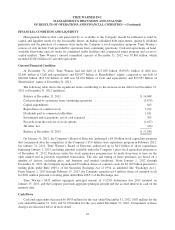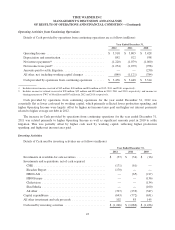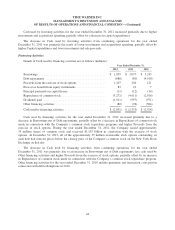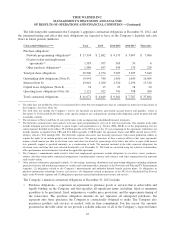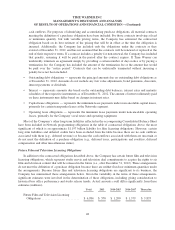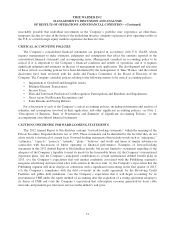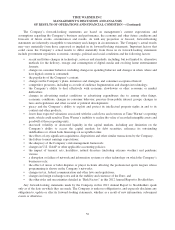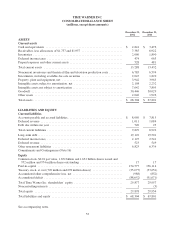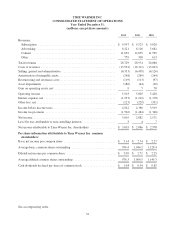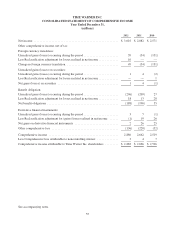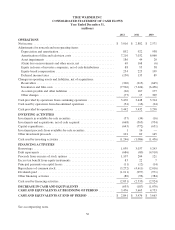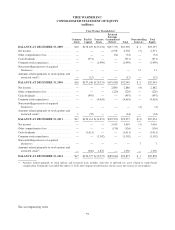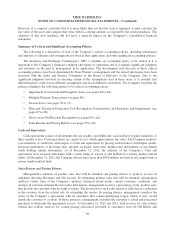Time Magazine 2012 Annual Report Download - page 65
Download and view the complete annual report
Please find page 65 of the 2012 Time Magazine annual report below. You can navigate through the pages in the report by either clicking on the pages listed below, or by using the keyword search tool below to find specific information within the annual report.TIME WARNER INC.
MANAGEMENT’S DISCUSSION AND ANALYSIS
OF RESULTS OF OPERATIONS AND FINANCIAL CONDITION – (Continued)
Contingent Commitments
The Company has certain contractual arrangements that require it to make payments or provide funding if
certain circumstances occur. See Note 16, “Commitments and Contingencies,” to the accompanying consolidated
financial statements for further discussion of this item.
Customer Credit Risk
Customer credit risk represents the potential for financial loss if a customer is unwilling or unable to meet its
agreed upon contractual payment obligations. Credit risk in the Company’s businesses originates from sales of
various products or services and is dispersed among many different counterparties. At December 31, 2012, no
single customer had a receivable balance greater than 5% of total Receivables. The Company’s exposure to
customer credit risk is largely concentrated in the following categories (amounts presented below are net of
reserves and allowances):
• Various retailers for home entertainment product of approximately $1.0 billion;
• Various television network operators for licensed TV and film product of approximately $3.0 billion;
• Various cable system operators, satellite service distributors, telephone companies and other distributors
for the distribution of television programming services of approximately $1.5 billion; and
• Various advertisers and advertising agencies related to advertising services of approximately
$1.4 billion.
For additional information regarding Time Warner’s accounting policies relating to customer credit risk,
refer to Note 1, “Description of Business, Basis of Presentation and Summary of Significant Accounting
Policies,” to the accompanying consolidated financial statements.
MARKET RISK MANAGEMENT
Market risk is the potential gain/loss arising from changes in market rates and prices, such as interest rates,
foreign currency exchange rates and changes in the market value of financial instruments.
Interest Rate Risk
Time Warner has issued fixed-rate debt that at December 31, 2012 and 2011 had an outstanding balance of
$19.620 billion and $19.251 billion, respectively, and an estimated fair value of $24.241 billion and $22.800
billion, respectively. Based on Time Warner’s fixed-rate debt obligations outstanding at December 31, 2012, a
25 basis point increase or decrease in the level of interest rates would decrease or increase, respectively, the fair
value of the fixed-rate debt by approximately $560 million. Such potential increases or decreases are based on
certain simplifying assumptions, including a constant level of fixed-rate debt and an immediate, across-the-board
increase or decrease in the level of interest rates with no other subsequent changes for the remainder of the
period.
At December 31, 2012 and 2011, the Company had a cash balance of $2.841 billion and $3.476 billion,
respectively, which is primarily invested in short-term variable-rate interest-earning assets. Based on Time
Warner’s short-term variable-rate interest-earning assets outstanding at December 31, 2012, a 25 basis point
increase or decrease in the level of interest rates would have an insignificant impact on pretax income.
Foreign Currency Risk
Time Warner principally uses foreign exchange contracts to hedge the risk related to unremitted or
forecasted royalties and license fees owed to Time Warner domestic companies for the sale or anticipated sale of
U.S. copyrighted products abroad because such amounts may be adversely affected by changes in foreign
currency exchange rates. Similarly, the Company enters into foreign exchange contracts to hedge certain film
49


